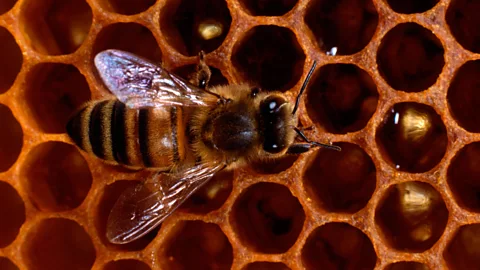This is where green policies make financial sense
 Alamy
AlamyThe cost-benefit analysis behind Herman Miller's release of thousands of bees at its offices.
In 1996, office furniture maker Herman Miller Inc completed construction of the GreenHouse — a manufacturing plant, offices and showrooms designed to be among the world’s most environmentally friendly buildings.
Recycling efforts would reduce landfill contribution to zero, natural light would replace the need for fluorescents, and plants would naturally clean the air.
Things were going well until the spring of 2000.
“Somehow, we ended up with a bad wasp problem,” recalled Michael Ramirez, senior vice president of people, places, and administration at Herman Miller. “There was something like 80,000 wasps.”
To avoid employees getting stung on their way into the office, Herman Miller planned to hire exterminators. Then, a maintenance manager spoke up. He argued the plan didn’t align with the company’s principles, which call for environmental sustainability. “He put his hand up and said, ‘No, that’s not what we stand for,’” Ramirez said.
 Alamy
AlamyAfter some research, the maintenance manager learned that a wasp’s natural enemy is the honey bee. So, Herman Miller brought in bee keepers and 600,000 honey bees went to work.
“We have a big storytelling culture at Herman Miller, and this honey bee story exists as a story we tell to our employees,” Ramirez said. “We want our employees to lead and to set the tenor for environmental responsibility.”
It’s not just about doing good. Managers can impact corporate policy in ways that help save the environment, improve the bottom line and help the company’s public perception in the process.
“This is as much an individual issue as it is a large corporation issue,” said CB Bhattacharya, professor and chair of sustainability at the European School of Management and Technology in Berlin. “Managers in relatively small positions can have large effects on the environment.”
Profits vs politics
Perhaps the biggest fear an executive may have when suggesting changes is how he or she might be perceived. It may, at first, seem like a manager is taking a — perhaps controversial or unpopular — political stance, but Bhattacharya said there’s a very simple way to dispel that fear.
“Managers, without being political, can put up a cost-benefit analysis to show changes that positively impact the environment can outweigh the costs,” he said.
The first step when raising a pro-environment idea is to approach higher-ups with a solution, rather than complaints about how things are currently being done, said Matt Segneri, director of the Social Enterprise Initiative at Harvard Business School.
 GreenHouse/Herman Miller Inc
GreenHouse/Herman Miller IncDemonstrate how the new idea aligns with the company’s mission and goals —
and that it will result in profitability. “Fundamentally, this is about innovation,” Segneri said. “It’s about looking at new areas that can have successful outcomes on the bottom line.”
With the honey bees, the cost-benefit analysis was simple: bringing in bee keepers cost less than exterminators. The bees also had an unexpected effect: they pollinated wildflowers in the fields surrounding the GreenHouse building.
Where to cut costs?
The first place to look for changes is the supply chain. Managers can cut costs by reducing the need for fossil fuels or recycling more to cut back on materials used in manufacturing, said Andrea Masini, associate professor at the HEC Paris business school.
“Planning for climate change is not only a constraint brought by regulation but also an opportunity to make money,” Masini said. “As a manager, you should step back, instead of just seeing the job as daily tasks, and see how your company is affecting the environment.”
Eco-conscious success
There are many examples of companies that have managed to make green-friendly practices profitable.
American outdoor clothing manufacturer Patagonia, for instance, changed its manufacturing process to be more environmentally friendly, and since 1985
has contributed 10% of pre-tax profits each year to environmental groups. The outdoorsy types attracted to Patagonia’s clothing are more likely to be concerned for the environment, so the move had the benefit of increasing sales, Masini said. In fact, Patagonia tripled profits from 2008 to 2013.
Airplane maker Boeing designed lighter aircraft that use less fuel, an initially expensive innovation that, in the long run, saves on fuel costs and cuts emissions.
And a decade ago at Mars Inc, three mid-level executives dreamed up an idea that the global food manufacturer could become sustainable within a generation. The company set “stretch goals” that seemed, at the time, impossible to attain, said Barry Parkin, the company’s global procurement head. Among the changes, the company set out to reduce greenhouse gas emissions every year by 3%, even if the 75,000-employee company continued to grow. Now, Mars is on target to reduce its output of greenhouse gasses by 2040. That’s in part thanks to a new wind farm Mars built in Texas; it’s the size of Paris and provides enough electricity to power all 70 of the company’s US facilities.
“Whether working on a production line or in logistics, we realised everybody could do something to help the environment,” Parkin said from his office in New York City. Now, he said, sustainability is one of the most talked-about issues in the company, because it gives employees something to feel good about at the end of the day.
Beyond the bees
At Herman Miller, the company established a simple guideline to help managers present new environmentally friendly ideas, Ramirez said. All new environmental projects should pay for themselves or produce a profit within three to five years.
That’s key, Ramirez said: it’s hard to convince upper management to spend money on environmental advancements unless you can also prove it’ll increase profitability.
It’s hard to convince upper management to spend money unless you can also prove it’ll increase profitability.
“It’s important that you understand profitability is important,” Ramirez said. “As you’re thinking about how to leave behind a better world, you have to think about how to protect your product.”
Among the efforts, the 110-year-old company has a group of employees tasked with creating environmental programs. It’s named Team 53, after the year Herman Miller founder DJ DePree declared his company would be “a good steward of the environment.”
The team is working to reduce Herman Miller’s contribution to landfills, and so far, seven of the company's facilities across the globe have done so. It’s not only a good environmental idea, Ramirez said, but the cost of recycling is less than the bills the company paid to dump its trash.
Not all eco-conscious projects will end up emptying landfills or creating fields of flowers but with careful study, managers really can dream up environment-saving ideas that make an impact.
